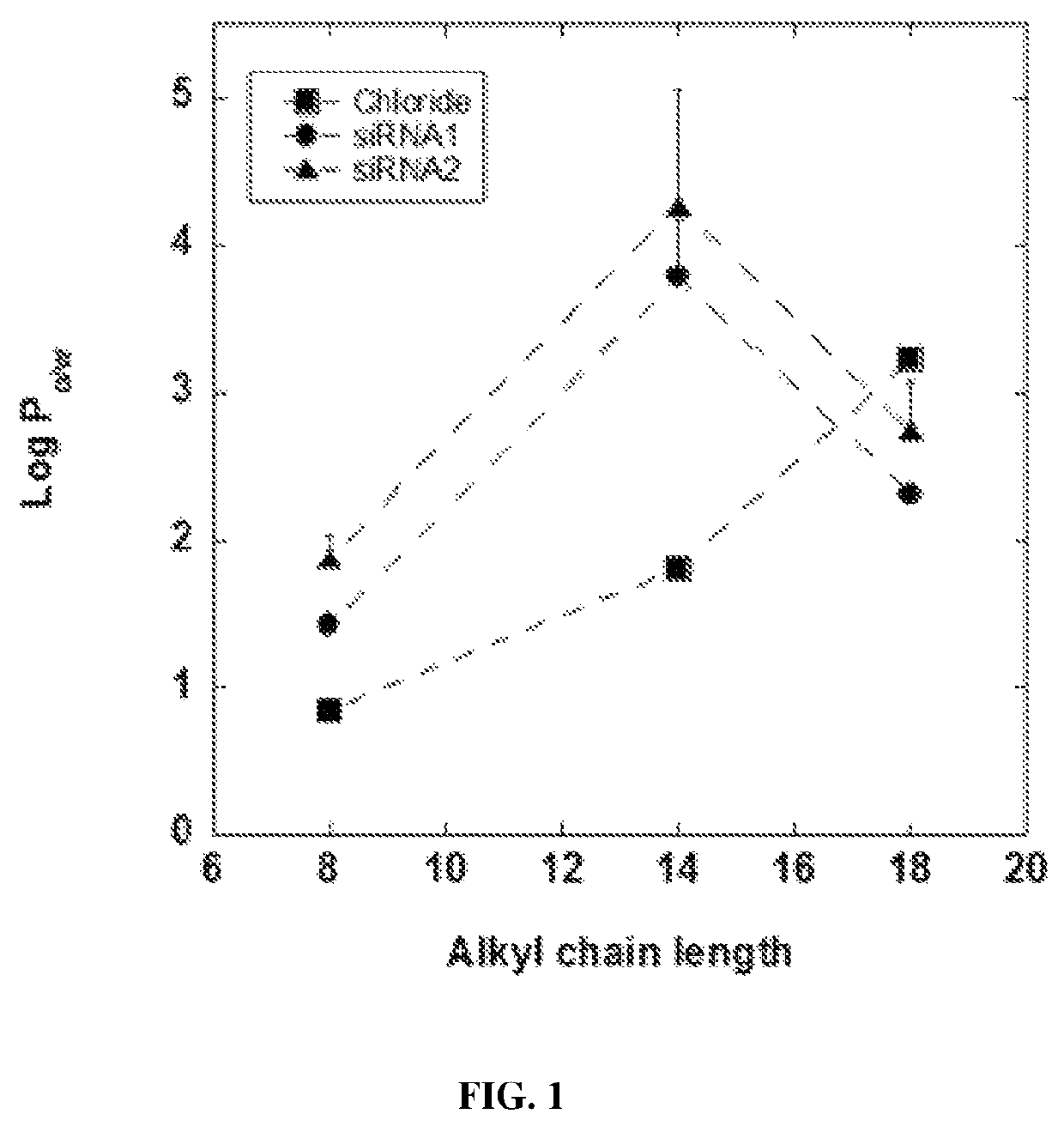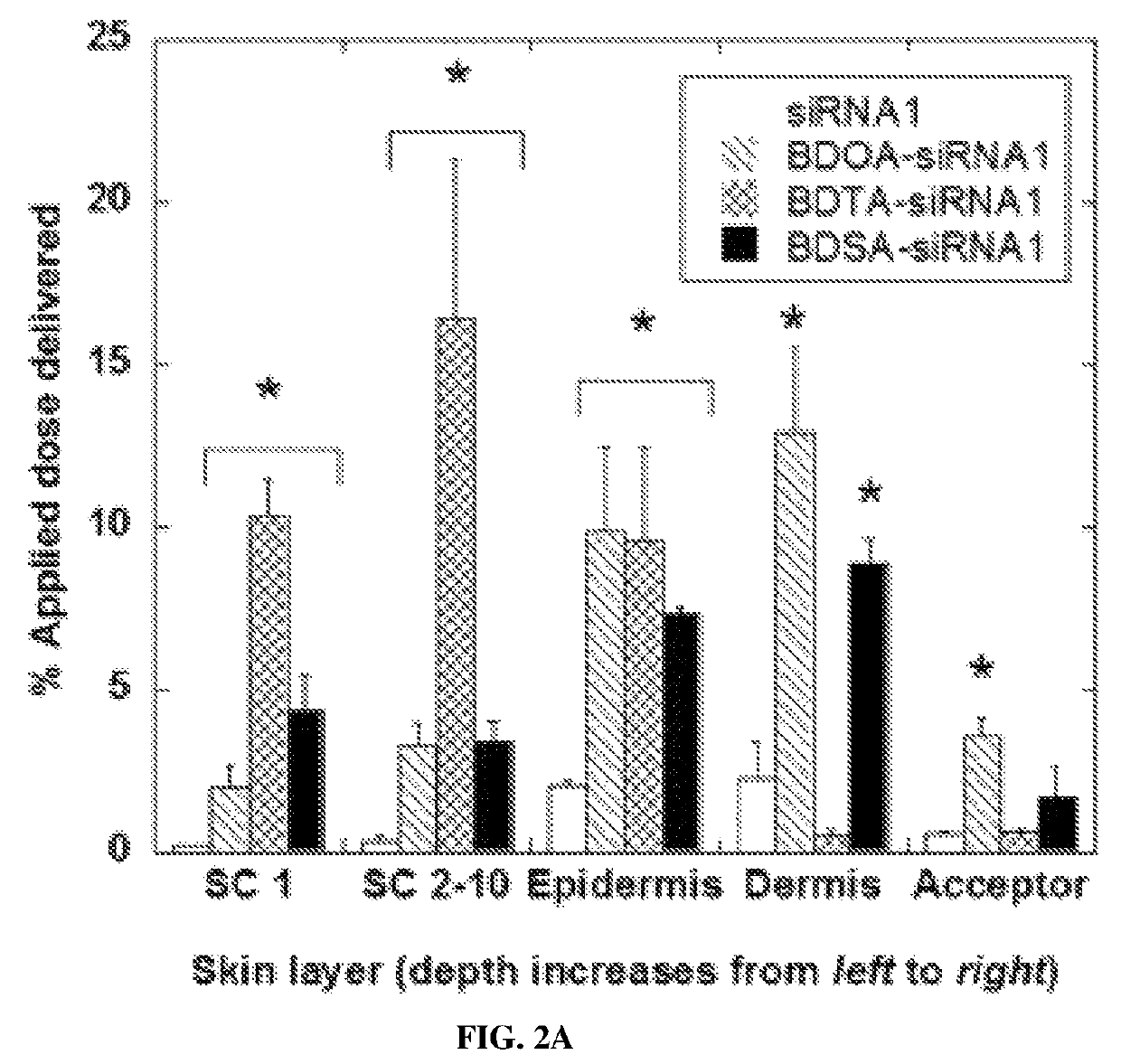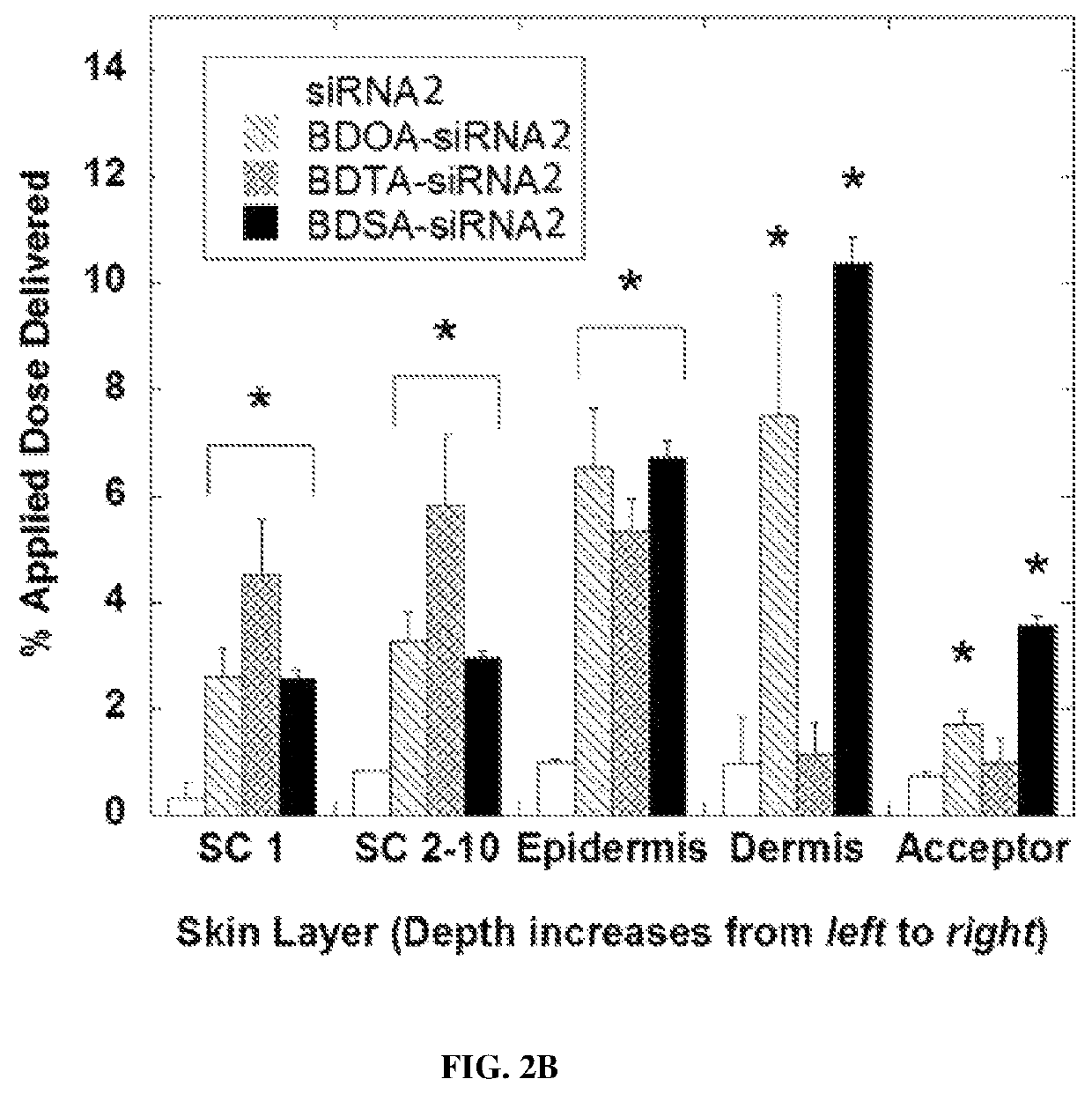Topical formulations based on ionic species for skin treatment
a technology of ionic species and formulations, applied in the direction of dermatological disorders, drug compositions, peptide/protein ingredients, etc., can solve the problems of significant physical, emotional and economic burden, poor treatment effect of skin diseases, and limited passive diffusion of many molecules,
- Summary
- Abstract
- Description
- Claims
- Application Information
AI Technical Summary
Benefits of technology
Problems solved by technology
Method used
Image
Examples
example 1
and Characterization of Robed-siRNAs
[0214]Materials and Methods
[0215]siRNA robed with ionic liquid (IL) moieties were synthesized by acid-base neutralization as described previously (Nishimura et al., Biomaterials, 26:5558-5563 (2005)). Benzyl dimethyl alkyl ammonium chloride salts were purchased from Sigma Aldrich (St. Louis, Mo.). FAM-GAPDH siRNA (siRNA1, 5′-FAM-GACGUAAACGGCCACAAG UUC-3′ (SEQ ID NO:1)), FAM-GAPDH siRNA (siRNA2, 5′-FAM-GUGUGAACCACGAGAAAUAUU-3′(SEQ ID NO:2)), FAM-Elastase siRNA (siRNA3, 5′-FAM-UCACUUACAGGAUCUAUAAUU-3′ (SEQ ID NO:3)), and FAM-Control siRNA (siRNA4, 5′-FAM-UAAGGCUAUGAAGAGAUACUU-3′ (SEQ ID NO:4)) were purchased from Dharmacon, Thermo Fisher Scientific (Waltham, Mass.).
[0216]Chloride salts were converted to their corresponding hydroxide salts using Amberlite IRA-402 hydroxide form anion exchange resin (Santa Cruz Biotechnology, Dallas, Tex.). Benzyldimethyl alkyl ammonium chloride salts were dissolved in ultrapure ddH2O (Life Technologies, Grand Island,...
example 2
NA is Efficiently Transported Through the Skin
[0233]Materials and Methods
[0234]Measurement of Skin Transport
[0235]Full thickness pig skin (Lampire Biological Laboratories, Pipersville, Pa.) was used in this study. All skin samples were stored at −80° C. Skin was defrosted and hair were trimmed immediately prior to use. Skin pieces were cleaned with PBS (pH 7.4) and skin conductivity was measured to ensure that the samples were intact. Skin penetration was assessed in Franz diffusion cells
[0236](FDCs) as described previously (Chen et al., Journal of Controlled Release, 179:33-41 (2014); Karande et al., Nature Biotechnology, 22:192-197 (2004)). Briefly, the receptor compartment was filled with PBS at pH 7.4. Each test formulation was assessed in triplicate. Skin was mounted with the SC facing up and the donor compartment left dry and open to atmosphere for 30 minutes before applying the test formulation. Caution was taken to remove all air bubbles between the underside of the skin (de...
example 3
NA is Not Toxic to Cells
[0242]Materials and Methods
[0243]Cell Culture
[0244]All cell culture materials were acquired from Life Technologies (Grand Island, N.Y.). Human adult epidermal keratinocytes were cultured in EpiLife Medium supplemented with Human Keratinocyte Growth Supplement, 25 U / mL penicillin, 25 μg / mL streptomycin, and 50 μg / mL neomycin. Cultures were grown at 37° C. with 5% CO2.
[0245]Evaluation of Biocompatibility in Cell Culture
[0246]Cells were seeded in a 96-well microplate (Corning Inc., Corning, N.Y.) and were allowed to attach and proliferate. Once cells reached ˜80% confluency, the media was removed and FAM-siRNA, robed-FAM-siRNA, or benzyl dimethyl alkyl ammonium chloride salts in media was added. Media alone was used as a control. Cells were incubated with test solution for 4 hours at 37° C. and 5% CO2. After incubation, test solutions were removed, cells were washed with HBSS, and fresh media was added to each well. Cells were allowed to proliferate overnight be...
PUM
| Property | Measurement | Unit |
|---|---|---|
| molecular-weight | aaaaa | aaaaa |
| molecular weight | aaaaa | aaaaa |
| molecular weight | aaaaa | aaaaa |
Abstract
Description
Claims
Application Information
 Login to View More
Login to View More - Generate Ideas
- Intellectual Property
- Life Sciences
- Materials
- Tech Scout
- Unparalleled Data Quality
- Higher Quality Content
- 60% Fewer Hallucinations
Browse by: Latest US Patents, China's latest patents, Technical Efficacy Thesaurus, Application Domain, Technology Topic, Popular Technical Reports.
© 2025 PatSnap. All rights reserved.Legal|Privacy policy|Modern Slavery Act Transparency Statement|Sitemap|About US| Contact US: help@patsnap.com



